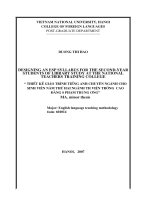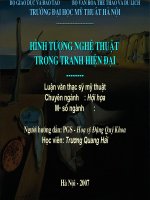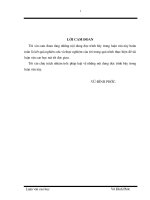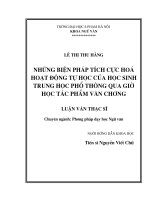(Luận văn thạc sĩ) designing text based tasks for the third year students of navigation faculty in vietnam maritime university
Bạn đang xem bản rút gọn của tài liệu. Xem và tải ngay bản đầy đủ của tài liệu tại đây (463.01 KB, 7 trang )
VIETNAM NATIONAL UNIVERSITY, HANOI
UNIVERSITY OF LANGUAGES AND INTERNATIONAL STUDIES
FACULTY OF POSTGRADUATE STUDIES
NGUYỄN THỊ PHƯỢNG
DESIGNING TEXT-BASED TASKS FOR THE THIRD-YEAR
STUDENTS OF NAVIGATION FACULTY
IN VIETNAM MARITIME UNIVERSITY
(Thiết kế các nhiệm vụ học tập dựa trên bài khóa cho sinh viên năm thứ ba
khoa Điều khiển tàu biển – Trường Đại học Hàng hải Việt Nam)
M.A MINOR PROGRAMME THESIS
Field:
English Teaching Methodology
Code:
60.14.10
HANOI – 2010
VIETNAM NATIONAL UNIVERSITY, HANOI
UNIVERSITY OF LANGUAGES AND INTERNATIONAL STUDIES
FACULTY OF POSTGRADUATE STUDIES
NGUYỄN THỊ PHƯỢNG
DESIGNING TEXT-BASED TASKS FOR THE THIRD-YEAR
STUDENTS OF NAVIGATION FACULTY
IN VIETNAM MARITIME UNIVERSITY
(Thiết kế các nhiệm vụ học tập dựa trên bài khóa cho sinh viên năm thứ ba
khoa Điều khiển tàu biển – Trường Đại học Hàng hải Việt Nam)
M.A MINOR PROGRAMME THESIS
Field:
English Teaching Methodology
Code:
60.14.10
Supervisor: Đinh Hải Yến, M.Ed
HANOI - 2010
4
TABLE OF CONTENTS
CONTENTS
PAGE
Declaration ................................................................................................................. i
Acknowledgement ..................................................................................................... ii
Abstract .................................................................................................................... iii
List of tables and figures ........................................................................................ viii
List of abbreviations ................................................................................................. ix
PART A: INTRODUCTION
1. Rationale of the study ............................................................................................ 1
2. Aims and objectives of the study ........................................................................... 3
3. Scope of the study ................................................................................................. 3
4. Methods of the study ............................................................................................. 4
5. Significance of the study........................................................................................ 4
6. Overview of the study............................................................................................ 5
PART B: DEVELOPMENT
CHAPTER 1: LITERATURE REVIEW
1. Defining tasks......................................................................................................... 6
2. Types of tasks ......................................................................................................... 8
3. Task-based framework............................................................................................ 10
4. Text-based tasks ..................................................................................................... 12
4.1. Defining texts in language teaching......................................................... 12
4.2. Tasks based on texts ............................................................................... 12
4.3. Designing text-based task ....................................................................... 13
5
5. Considerations in task design .................................................................................. 13
6. Using texts in the teaching of English for Specific Purpose...................................... 15
7. Summary ................................................................................................................. 16
CHAPTER 2: METHODOLOGY
1. Background of the study ......................................................................................... 17
1.1. Current learning and teaching of English in general and ESP
in particular at Vietnam Maritime University ................................................. 17
1.2. Identification of the problem ................................................................... 17
2. Research questions ................................................................................................. 19
3. Participants ............................................................................................................. 19
4. Implementation of the action research..................................................................... 20
5. Data collection procedures...................................................................................... 21
5.1. Description of the pre-treatment questionnaire ........................................ 21
5.2. Description of the pre-treatment interview .............................................. 22
5.3. Description of the students’ diary ............................................................ 22
5.4. Description of the post – treatment questionnaire .................................... 23
5.5. Description of the post – treatment interview .......................................... 24
6. Data analysis procedures ........................................................................................ 24
7. Summary ................................................................................................................ 24
CHAPTER 3: RESULTS AND DISCUSSION
1. Phase One: Conducting pre-treatment questionnaire survey and interview .............. 25
1.1. The results of the pre-treatment questionnaire survey ............................. 25
1.1.1. Students’ needs ............................................................................ 25
6
1.1.2. The ESP course............................................................................ 26
1.2. The results of the pre-treatment interview .............................................. 30
2. Phase Two: Conducting the trial lessons ................................................................. 32
2.1. The implementation of the trial lessons .................................................. 32
2.2. The results of the students’ diary ............................................................ 32
3. Phase Three: Conducting post-treatment questionnaire survey and interview .......... 33
3.1. The results of the post-treatment questionnaire survey ........................... 33
3.1.1. Students’ motivations .................................................................. 33
3.1.2. Language skill development......................................................... 33
3.1.3. The trial lessons’ sequence........................................................... 34
3.2. The results of the post-treatment interview .............................................. 37
4. Summary ................................................................................................................ 38
PART 3: CONCLUSION
1. Summary and conclusions ...................................................................................... 39
2. Pedagogical implications ........................................................................................ 40
3. Limitations of the study and suggestions for further study ...................................... 41
REFERENCES........................................................................................................... 43
APPENDICES
Appendix 1: A sample unit in the course book “Business English for Seamen” ........... I
Appendix 2: A sample lesson plan ............................................................................ IV
Appendix 3: Two samples of students’ diaries ....................................................... XIII
Appendix 4: Pre-treatment questionnaire survey (English version) ......................... XV
3
Abstract
For some recent decades, task-based language learning and teaching (TBLT) has,
been familiar with scholars, researchers, teachers and students all over the world; however,
its applicability seems to be more on the teaching of general English than English for
Specific Purpose (ESP). The purpose of this study was to examine the needs and
assessments of students from Navigation Faculty in Vietnam Maritime University when
learning ESP, and suggest effective ways to design tasks based on available texts in the
course book. Both quantitative and qualitative research methodologies were utilized in this
action research study. The quantitative research data were gathered with the aids of two
questionnaire surveys, with the first being administered before the trial lessons (102
respondents out of 105 questionnaires sent out) and the second one after the trial lessons
(103 respondents out of 105 questionnaires sent out). The qualitative research data were
collected from two in-depth interviews with the students for the insightful information
about students’ judgments towards the teaching and learning of ESP before and after the
trial lessons. The results of the first questionnaire survey revealed a high level of
dissatisfaction within the students towards the current ESP course in terms of need
fulfillments, language skill development and classroom activities. This was reassured by
the results of the first interview with students, the result of which proved that students were
unhappy with the course due to the lack of communicative activities such as discussion and
listening. The second survey, which was conducted after the trial lessons, however saw a
positive change in the students’ motivations and attitudes on the ESP course. They felt that
they were learning for pleasure and they liked the ways they learned ESP from the tasks
designed on the given texts. The results from the after-treatment interview also confirmed
that students would like to have more lessons as such in the future. Hopefully, this research
can create a beginning for the new way of approaching texts in ESP.
Thank you for evaluating AnyBizSoft PDF
Merger! To remove this page, please
register your program!
Go to Purchase Now>>
AnyBizSoft
PDF Merger
Merge multiple PDF files into one
Select page range of PDF to merge
Select specific page(s) to merge
Extract page(s) from different PDF
files and merge into one









